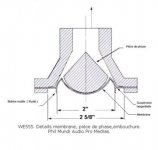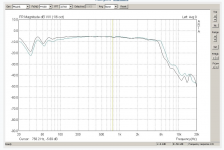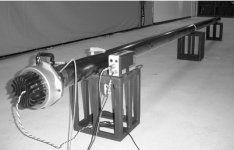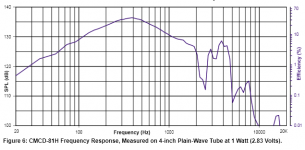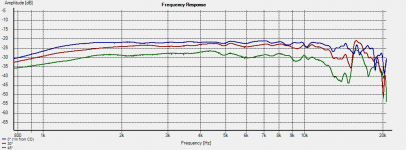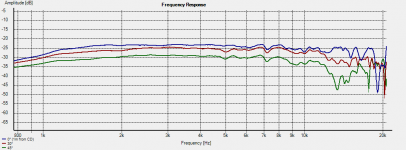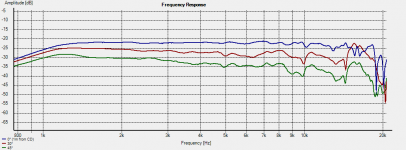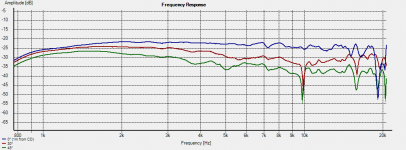The Atlas/Klipsch vs WE 555W (dis)similarities were discussed before here, by you, Bear. 
http://www.diyaudio.com/forums/mult...-we-555-dissect-design-diy-6.html#post3290735
http://www.diyaudio.com/forums/mult...-we-555-dissect-design-diy-6.html#post3290735
Last edited:
Radian: Here is a guy talking about the Klipsch K55, and possible replacements. Seem like he thinks the K55 is not good enough below 500Hz, and that a 2" replacement CD is needed.
Klipsch loudspeaker corner
"1 Inch or 2 Inch drivers ?
Should I spend the extra money for a 2 Inch throat driver and horn? They say that a 2 inch horn is supposed to be better. The truth is that this is quite true, but the difference is hard to measure at normal listening levels. Look at the intermodulation distortion plots of a 1 inch driver on a 1-inch horn versus a 2 inch driver on the 2 inch horn. The small "spikes" on the bottom line are the distortion products. This illustrates how even a high quality 1-inch driver will overload when used on a Klipschorn at moderately high levels. There is no quality 1-inch driver that will handle 400 Hz without distorting the sound. These drivers all have light metal diaphragms designed to go up high in frequency. They won't go down like the phenolic diaphragm in the stock K55 will. The only drivers that will are 2 Inch drivers! The Klipschorn squawker driver needs to handle the 450 Hz tone because the woofer won't go up that high. The Belle Klipsch and LaScala can be crossed over at 500 Hz. The 450 Hz tone would go to the woofer, so the Belle and LaScala don't have this problem to such a degree.
The real reason to move to a 2-inch horn is to allow a better driver than the stock K55 to be used. This is why a 2-inch horn is being suggested, not to extend the lower limit of the midrange! There is simply no 1-inch driver that will do! The B&C DCM50 driver is being offered for 2-inch horns. It was designed for the 400 Hz crossover required by the Khorn."
Ah, Al Klappenberger. He is well known for his Crossover modifications of the
Klipsch speakers.
The truth is you will not find another driver who is more suitable for those
frequencies. Did you pay attention to the distortion figures that Dietmar has
mesured? The little modifications did wonders on the D3 distortion figures.
The surface area of the diaphragm that a 2" exit driver has to theoretically
exibit a better bottom end with less distortion is not all there is to a well
suited driver for low frequencies.
The K55 has a very low resonat frequency and a max excursion of 1mm. You
will not find that in other modern drivers because they have not been
designed to cover low fequencies. People who have heard the big WE horns
with the W555 report a fantastic effortless sound in the lower region. The
driver seems to deliver what the horn calls for.
Atlas has continued on the the W555 design because they specialize in
pagging horns. Those are not supported by any low frequency device.
One driver needs to go as low and high as possible to cover the human voice
to be heard loud and clear over long distances. That calls for max
excursion and low distortion to be tollerable on the human ear.
As I said before, the way the compression is achieved in the WE/Atlas drivers
is very smart and smooth and allows for an excursion that is not possible with
modern slit design compression drivers.
Klaus
Let's not forget that 1mm for a 2" diaphragm will move the same volume of air as only 0.25mm on a 4" diaphragm (JBL 2482 and the like)
If it was that easy.
A JBL 2482 and the like will still not nearly achieve what the WE555 or Atlas can
do on a big horn. Diaphragm size is not all it needs.
Klaus
Of course the comparison would only be valid if both drivers are bolted to the same horn.If it was that easy.
A JBL 2482 and the like will still not nearly achieve what the WE555 or Atlas can
do on a big horn. Diaphragm size is not all it needs.
Klaus
Performance in the top end will depend on the phasing plug, diaphragm breakup, and mass break point (motor strength vs diaphragm weight), whereas performance in the low end will depend on the horn loading and air displacement capability of the diaphragm (Xmax*Sd).
So when used on the same horn, the 2482 would only need 1/4 of diaphragm travel compared to the Atlas to move the same quantity of air and get the same SPL at low frequency.
A large diaphragm has not nearly the structural strength of
the little 2" inverted dome. The very thing that buys us a better hf extension
causes more distortion on the low end. At little excursion all is fine but
when we need more low end more air has to exit through the slits and we get
multiple non uniform pressure points on one large area, the thin duralmin diaphragm.
The way the Atlas/WE driver achieves the compression is top and shoulder
ahead. You get uniform pressure build up on a structural already stable
diaphragm, exhibiting very little distortion coming from the diaphragm itself.
Another thing that is often overlooked in a driver that has to work in a too
broad frequency band is the hf reproduction. At a thenth of a watt all is fine.
You invite people over for a little party or you take your gear outdoors and
now you need more than a watt. To reproduce your desired 200hz
signal the diaphragm has left its ideal environment, meaning the high BL force
needed to reproduce an adequate hf signal is not there anymore. HF is still
there but it is not as accurate as it would be if the coil was in the ideal air
gap position. This translates into a loss of fine detail and a diffuser image.
The exact same thing happens to full range drivers.
If I pushed my fonken with FE127 a little to much it started to
sound like any cheap speaker, while before it had excellent detail and a very
3D like sound-stage when operated under this certain threshold.
Klaus
the little 2" inverted dome. The very thing that buys us a better hf extension
causes more distortion on the low end. At little excursion all is fine but
when we need more low end more air has to exit through the slits and we get
multiple non uniform pressure points on one large area, the thin duralmin diaphragm.
The way the Atlas/WE driver achieves the compression is top and shoulder
ahead. You get uniform pressure build up on a structural already stable
diaphragm, exhibiting very little distortion coming from the diaphragm itself.
Another thing that is often overlooked in a driver that has to work in a too
broad frequency band is the hf reproduction. At a thenth of a watt all is fine.
You invite people over for a little party or you take your gear outdoors and
now you need more than a watt. To reproduce your desired 200hz
signal the diaphragm has left its ideal environment, meaning the high BL force
needed to reproduce an adequate hf signal is not there anymore. HF is still
there but it is not as accurate as it would be if the coil was in the ideal air
gap position. This translates into a loss of fine detail and a diffuser image.
The exact same thing happens to full range drivers.
If I pushed my fonken with FE127 a little to much it started to
sound like any cheap speaker, while before it had excellent detail and a very
3D like sound-stage when operated under this certain threshold.
Klaus
Attachments
Last edited:
That BL vs excursion thing that you are explaining here preached for the largest possible diaphragm...
The phasing plug geometry does not come into play that much at low frequencies: the only thing that matter there is the compression ratio. It does come into play at higher frequencies of course, but there I'd expect the slit of the 2482 to behave better than the one of the Atlas... (and of course none of these drivers shall be used too high...)
By the way, the 2482 uses a phenolic diaphragm.
The phasing plug geometry does not come into play that much at low frequencies: the only thing that matter there is the compression ratio. It does come into play at higher frequencies of course, but there I'd expect the slit of the 2482 to behave better than the one of the Atlas... (and of course none of these drivers shall be used too high...)
By the way, the 2482 uses a phenolic diaphragm.
Radian, I am afraid we will have to have some disagreement about the differences.
The response you show is very good (unclear what the smoothing is) but it is not nearly as good as the documented response on the Azura horn with the Yamaha. The HF response of the K55/Atlas driver is not even in the same ballpark. As far as I can see the LF response shown is very much similar to what the Yamaha will do on a an appropriate horn.
No matter the K55 is an interesting driver as long as you can live with the HF rolloff.
The response you show is very good (unclear what the smoothing is) but it is not nearly as good as the documented response on the Azura horn with the Yamaha. The HF response of the K55/Atlas driver is not even in the same ballpark. As far as I can see the LF response shown is very much similar to what the Yamaha will do on a an appropriate horn.
No matter the K55 is an interesting driver as long as you can live with the HF rolloff.
That BL vs excursion thing that you are explaining here preached for the largest possible diaphragm...
The phasing plug geometry does not come into play that much at low frequencies: the only thing that matter there is the compression ratio. It does come into play at higher frequencies of course, but there I'd expect the slit of the 2482 to behave better than the one of the Atlas... (and of course none of these drivers shall be used too high...)
By the way, the 2482 uses a phenolic diaphragm.
Both are well known phenomenons, so I guess we have to agree to disagree.
I don't even know what you are trying to tell me.
The BL product (force) to produce hf is way more than for low freqencies.
The BL product decreases the more the coil leaves the ideal air gap.
If you try to go as low as possible with a big horn pushed for higher spl and on the same time try to reproduce lets say 12k to 16k it will not nearly sound as good as the same driver on a small horn cut off below 500 hz or so.
That is fact and you can even try it with a fullrange driver pushed to hard.
Forget about the 2482 it will not outperform a WE555 on a big horn.
If you get the following low end extension with the JBL I will stand corrected.
Messured on a plane wave tube.
Attachments
If you try to go as low as possible with a big horn pushed for higher spl and on the same time try to reproduce lets say 12k to 16k it will not nearly sound as good as the same driver on a small horn cut off below 500 hz or so.
Who suggested such an application?
The comparison of the Atlas and 2482 (or other 4" midbass compression driver) can of course only be done on the same horn, same bandwidth, and same SPL!
Regarding the plane wave tube response you posted, it is indeed impressive.
What is the input level and absolute SPL?
Did you measure it yourself?
Is it a valid plane wave tube? (quite important matter at these frequencies)
Radian, I am afraid we will have to have some disagreement about the differences.
The response you show is very good (unclear what the smoothing is) but it is not nearly as good as the documented response on the Azura horn with the Yamaha. The HF response of the K55/Atlas driver is not even in the same ballpark. As far as I can see the LF response shown is very much similar to what the Yamaha will do on a an appropriate horn.
No matter the K55 is an interesting driver as long as you can live with the HF rolloff.
Sorry Bear,
the whole time I was not talking about HF of the Altlas because HF from the
the Azura is not acceptable to me any way. That's what I have been trying
to explain all along. That horn is good to maybe 2500hz. The high freqencies
in that horn are bounced like ping pong balls. It looses it's pattern to early
to have satisfactory hf reproduction. A CD horn will walk all over it when it
comes to natural undistorted hights. So why waist a driver like the Yamaha
on this type of horn. Romy's horn is much better suited as it goes down to
about 120hz and only up to 1200hz where the Vitavox takes over.
Klaus
Klaus,
Afaik the Azura is either a tractrix or JMMC type.
I am not sure what you mean by the HF being bounced around like ping pong balls...
Could you provide an example of a suitable CD horn?
(btw, I hate that "CD" nomenclature, it always confuses. Is it Constant Dispersion or Constant Directivity?? Needs to be changed to something else, imho)
Personally I do not like to split the band in the center, I prefer to have the widest band reproduced by a single source, so 1200Hz xover points are generally not to my liking.
(having said that, I just set up a test system with just such a xover point, using an SA8535 and a TAD 1201 - so much for sticking to my design philosophies!)
_-_-
Afaik the Azura is either a tractrix or JMMC type.
I am not sure what you mean by the HF being bounced around like ping pong balls...
Could you provide an example of a suitable CD horn?
(btw, I hate that "CD" nomenclature, it always confuses. Is it Constant Dispersion or Constant Directivity?? Needs to be changed to something else, imho)
Personally I do not like to split the band in the center, I prefer to have the widest band reproduced by a single source, so 1200Hz xover points are generally not to my liking.
(having said that, I just set up a test system with just such a xover point, using an SA8535 and a TAD 1201 - so much for sticking to my design philosophies!)
_-_-
Klaus, as you don't seem interested in answering my questions regarding your PWT measurement, let me show you what a proper measurement should look like:
Here is the measurement of a JBL CMCD 8" driver, with a 4" throat on a proper plane wave tube:
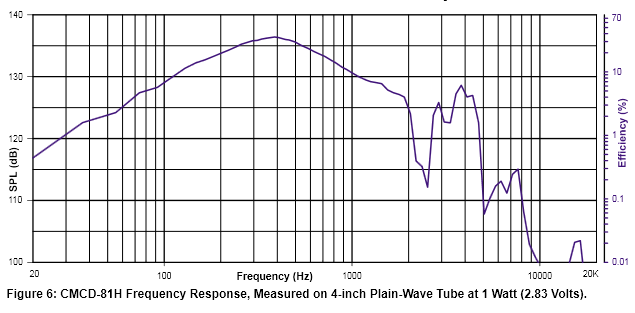
Everything can be seen on this measurement:
- absolute SPL level vs frequency for a given input voltage
- the low frequency rolloff from the back chamber acoustic suspension
- the mass break point frequency (-3dB around 700Hz, exactly where the theory said it would be: BL^2/(Pi*Mms*Re), check the 2250H here) and subsequent rolloff
- the breakups above 2kHz
Just for the reference, here in the PWT used for this measurement:
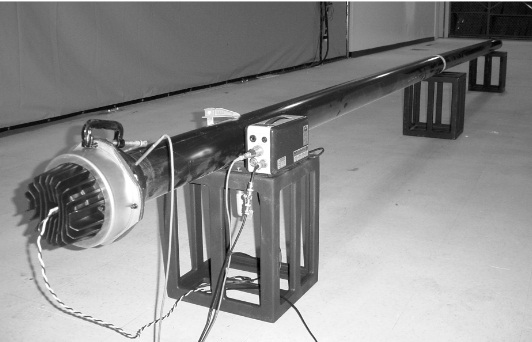
Now comparing that measurement to your (?) measurement above:
- what is the absolute SPL and input level?
- where is the acoustic suspension rolloff?
- where is the mass break point? (don't tell me 5kHz )
)
- where are the breakups?
Do you really expect that $100 Atlas driver (2" diaphragm, 1" exit) to have better low frequency performances (SPL and distortion at a given frequency) than the last iteration of JBL compression drivers (8" diaphragm, 4" exit) ?
Here is the measurement of a JBL CMCD 8" driver, with a 4" throat on a proper plane wave tube:
Everything can be seen on this measurement:
- absolute SPL level vs frequency for a given input voltage
- the low frequency rolloff from the back chamber acoustic suspension
- the mass break point frequency (-3dB around 700Hz, exactly where the theory said it would be: BL^2/(Pi*Mms*Re), check the 2250H here) and subsequent rolloff
- the breakups above 2kHz
Just for the reference, here in the PWT used for this measurement:
Now comparing that measurement to your (?) measurement above:
- what is the absolute SPL and input level?
- where is the acoustic suspension rolloff?
- where is the mass break point? (don't tell me 5kHz
- where are the breakups?
Do you really expect that $100 Atlas driver (2" diaphragm, 1" exit) to have better low frequency performances (SPL and distortion at a given frequency) than the last iteration of JBL compression drivers (8" diaphragm, 4" exit) ?
Attachments
Woha, Cool down please,
1. This is only my opinion and not to be taken as gospel.
2., Romy has posted pictures and drawings of his horn and there is nothing
we don't know about it.
3. He has been using it, at least for a wile, all the way up to about 1,2 khz
as far as I know.
4. John Hasqin has build Romy's horn. It's a simple tractrix contour. Nothing
special. John is one of the most respected people when it comes to horn
speakers especially tractrix and it's iterations. He himself has stated several
times that the Fane would benefit from a phase plug .
4: There are plenty white papers on the net that show how important it is to
get the compression ratio and throat design right for ultimate performance.
5. Common sense and a the study of nature is all it needs to understand that
letting a cone even if only partially push against a flat piece of board is not
very wise and will cause a number of unwanted effects even in the lower
mid region.
A teacher in the field of hydraulics or aerodynamics would shake his head
upon the way this design tries to achieve the compression.
The throat is a high pressure/low velocity region that needs a passage as
smooth as possible to prevent unwanted turbulences which are in regard to
sound waves just phase and amplitude irregularities that our ears are
sensitive to.
Anyone who believes that these are not audible in the range this horn works
in is in my opinion naive.
It's easy to see that my proposal is not about a simple phase plug that
achieves a better hf behavior.
Klaus
Klaus, I do not know why you need to tell me to cool down, I am not overly hot. I express to the reasons and I hope you do the same. Anyhow….
There is absolutely no need to bring John Hasqin to the conversation as you did not stated that John feels that the Romy’s horn was improperly design but you stated it yourself, so I was asking YOUR reasoning. Romy horn is not up to 1,2 kHz but rather up 500Hz. You might look at the circuit, the channel B:
http://www.goodsoundclub.com/Site_Images/6-Chennal_Melquiades_DSET_Amplifier_Rev3.jpg
I never heard that John Hasqin advocated phase plug for Fane and if he did then he might be wrong. Nevertheless, I doubt that at 500Hz that Romy use his horn any conversation about phase plug would be valid. The “white papers on the net that show how important it is to
get the compression ratio and throat design right for ultimate performance” is very invalid argument. If you want to moderate compression ratio then be advised that phase plug is NOT a way to do if for LF. The compression ratio might be set by the ration between the driver and the throat and by a few other things but not by phase plug. The phase plug moderates the phase cancelations and those cancelations take place at the wave lengths that are equitable with the size of the phase plug paths. At 500Hz the wave is 70 cm and at 100Hz is 3.4m. The Romy’s horn throat with 4” entrance is absolutely irrelevant at those frequencies.
Your vision of cone pushing against a flat piece of board is not accurate. The cone pushed against the throat reactance and in Romy case the throat reactance was equated into the horn design and the calibration of back chamber.
I understand that anyone who believes that the things you advocate are audible and the people who do not believe in it are naive. However, what I am saying you is not about theory of “what people say in line” but the fact that I was experimenting with Fane and Romy’s horn and I did implement a 2-3 versions of phase plug for it. I did not detect any changes under 1000Hz that in my view addressed my curiosity. I truly do not see that Romy upperbass is improperly designed as you claimed. If you would like to replicate what Romy did and would like to use his-style horn/driver to accomplish different sound then you are perfectly in your right to do so by change any aspect of design you wish. However if I were you I would not start your journey in the field with sweeping statements that Romy’s upperbass is “improper horn for that driver”,… unless you have evidence…. Do you?
I became curious of CMCD drivers. Here is review of a PA speaker called JBL STX835 with these JBL CMCD installed.
Interestingly this guy prefers the EAW KF650 (KF650z - eaw) over the JBL STX835. The winner in his comparison - the EAW KF650 has a 15" for bass, and hornloaded 10" cone driver for midrange, and the tweeter is a hornloaded 1.4" compression driver, with a 3" voice coil.
He found that the JBL STX835 were less harsh than the previous JBL SRX725, which has a 15" and a hornloaded JBL 2451 which is 1.5" compression driver with 4" voice coil. To me crossing a 15" driver at 1200Hz is pretty bad, and may very well be the cause of the harshness, not the compression driver. The JBL 2451 compression driver can be crossed at 500Hz, so I don't know why they don't use it as mids as well. An XO at 6-800Hz would probably have sounded much better, but may then have needed an extra channel for a hornloaded tweeter.
I don't know what to think of his conclusion. He likes the 3-way JBL STX835, over the 2-way JBL SRX725, but the SRX725 has a pretty retarded crossover. He think the STX835 is inferior to the 3-way EAW KF650, but the KF650 lack information about its crossover points. The only difference I know is that the KF650 uses a hornloaded 10" driver instead of a hornloaded JBL CMCD 8". I am guessing all three use their compression drivers above 1.2kHz. And we want to use them below 200Hz. So the comment about CMCD being less harsh than a SRX725 is either due to 15" crossed to high, or that the JBL 2451 is a bad tweeter. Or it is a good tweeter in a less than optimal crossover.
The review: JBL STX835 - show review/report
"So this past weekend I had a show at Wolf Trap for their end of year Ball/Gala/Party. There was an estimated 800-850 dinner plates sold for this shin-dig. Wolf Trap is buying the STX835 to replace Meyer MSL3 (non-powered) for small mains, side fill and drum monitor and they will be using Lab Gruppen PLM's to power these boxes. For this evening, the speakers only had a 90Hz HP and set-up in Full Range mode (they unboxed them 2 days before the gig and JBL hasn’t created DSP presets yet). The STX was stacked on top of L'Acoustic SB218 (PLM powered & processed).
I can say that these speakers do sound very good. I did have to make a few small cuts on the 31Band EQ to smooth out the box, other than that it's a good speaker out of the box. The only "down fall" that I see with these boxes is that the horn flares are in the middle of the box, so you'll need to stack it high. The speaker is a step up from the older SRX725, but it’s still a slight step behind the KF650."
"...Hmm, what do the STX sound like?
The biggest improvement I heard with the STX835 over the SRX725 is the Horn sound; it has lost some of the "harshness" that some people seemed too complain about. But no worries, it still has some of the 'edgy-ness' that JBL is known for in a good way. It is a good improvement over the SRX725. [Note: SRX725 has no compression driver below 1200Hz, just two 15 inch drivers]
When walking around in front of the speakers, I could hear when you walked out of the pattern. They did sound better than the 2 L’Acoustic ARCS zones (3 wide with 1 pointing down flown above the doorway pointing into SL & SR rooms); the ARCS lacked Mids."
Interestingly this guy prefers the EAW KF650 (KF650z - eaw) over the JBL STX835. The winner in his comparison - the EAW KF650 has a 15" for bass, and hornloaded 10" cone driver for midrange, and the tweeter is a hornloaded 1.4" compression driver, with a 3" voice coil.
He found that the JBL STX835 were less harsh than the previous JBL SRX725, which has a 15" and a hornloaded JBL 2451 which is 1.5" compression driver with 4" voice coil. To me crossing a 15" driver at 1200Hz is pretty bad, and may very well be the cause of the harshness, not the compression driver. The JBL 2451 compression driver can be crossed at 500Hz, so I don't know why they don't use it as mids as well. An XO at 6-800Hz would probably have sounded much better, but may then have needed an extra channel for a hornloaded tweeter.
I don't know what to think of his conclusion. He likes the 3-way JBL STX835, over the 2-way JBL SRX725, but the SRX725 has a pretty retarded crossover. He think the STX835 is inferior to the 3-way EAW KF650, but the KF650 lack information about its crossover points. The only difference I know is that the KF650 uses a hornloaded 10" driver instead of a hornloaded JBL CMCD 8". I am guessing all three use their compression drivers above 1.2kHz. And we want to use them below 200Hz. So the comment about CMCD being less harsh than a SRX725 is either due to 15" crossed to high, or that the JBL 2451 is a bad tweeter. Or it is a good tweeter in a less than optimal crossover.
The review: JBL STX835 - show review/report
"So this past weekend I had a show at Wolf Trap for their end of year Ball/Gala/Party. There was an estimated 800-850 dinner plates sold for this shin-dig. Wolf Trap is buying the STX835 to replace Meyer MSL3 (non-powered) for small mains, side fill and drum monitor and they will be using Lab Gruppen PLM's to power these boxes. For this evening, the speakers only had a 90Hz HP and set-up in Full Range mode (they unboxed them 2 days before the gig and JBL hasn’t created DSP presets yet). The STX was stacked on top of L'Acoustic SB218 (PLM powered & processed).
I can say that these speakers do sound very good. I did have to make a few small cuts on the 31Band EQ to smooth out the box, other than that it's a good speaker out of the box. The only "down fall" that I see with these boxes is that the horn flares are in the middle of the box, so you'll need to stack it high. The speaker is a step up from the older SRX725, but it’s still a slight step behind the KF650."
"...Hmm, what do the STX sound like?
The biggest improvement I heard with the STX835 over the SRX725 is the Horn sound; it has lost some of the "harshness" that some people seemed too complain about. But no worries, it still has some of the 'edgy-ness' that JBL is known for in a good way. It is a good improvement over the SRX725. [Note: SRX725 has no compression driver below 1200Hz, just two 15 inch drivers]
When walking around in front of the speakers, I could hear when you walked out of the pattern. They did sound better than the 2 L’Acoustic ARCS zones (3 wide with 1 pointing down flown above the doorway pointing into SL & SR rooms); the ARCS lacked Mids."
Last edited:
(btw, I hate that "CD" nomenclature, it always confuses. Is it Constant Dispersion or Constant Directivity?? Needs to be changed to something else, imho) _-_-
I woke up last night realizing I have been using "CD" for "compression driver". But I am a beginner, you should know better.
The horn used in the SRX725 in a very good one, and a bit larger (and especially higher) thant the small PT waveguide used in the STX835.
Its profile looks similar to an OS or quadratic.
The 2451/2452 compression driver use in the SRX is also a bit better than the 2432 used in the STX, but it would arguably be better (less hash) with an SL (aquaplassed) diaphragm...
If you are interested by these horns, here are some directivity measurement of a 2450SL driver with truextent Be diaphragms, with EQ, on the SRX725 horn and a 90x50 PT waveguide (similar to the one found in the STX series).
horizontal SRX:
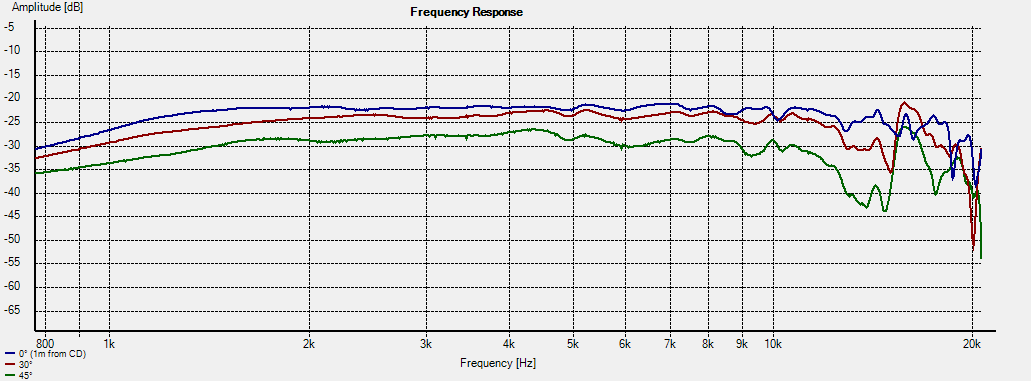
horizontal PT:
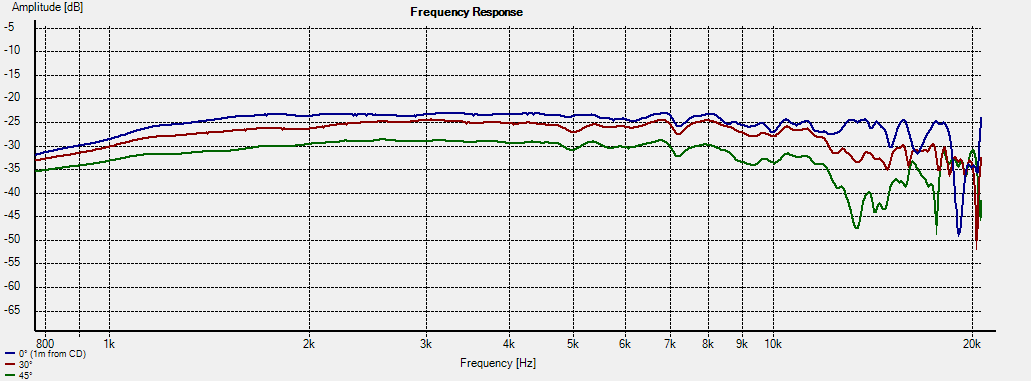
vertical SRX:
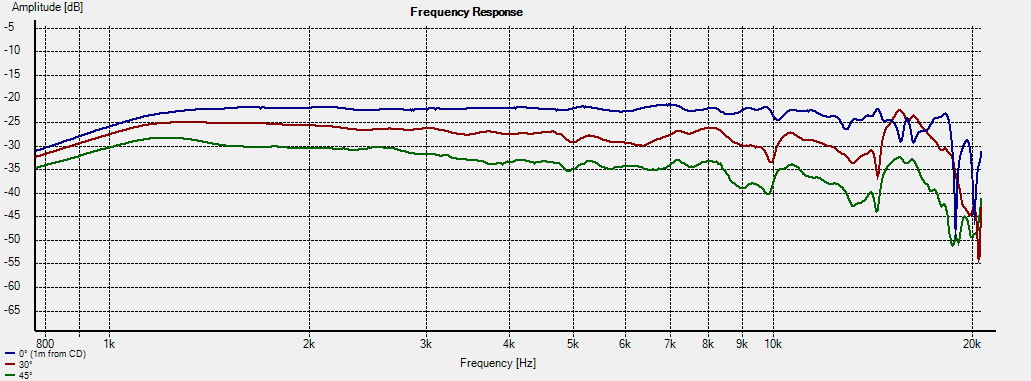
vertical PT:
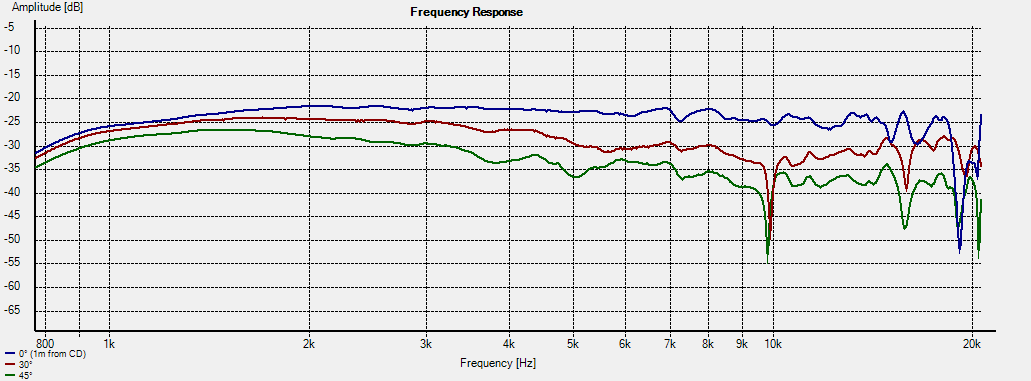
Both horns are very smooth, and in the realms of 80° horizontal beamwidth, and the SRX horn also gains vertical directivity lower in frequency thanks to its higher profile.
Its profile looks similar to an OS or quadratic.
The 2451/2452 compression driver use in the SRX is also a bit better than the 2432 used in the STX, but it would arguably be better (less hash) with an SL (aquaplassed) diaphragm...
If you are interested by these horns, here are some directivity measurement of a 2450SL driver with truextent Be diaphragms, with EQ, on the SRX725 horn and a 90x50 PT waveguide (similar to the one found in the STX series).
horizontal SRX:
horizontal PT:
vertical SRX:
vertical PT:
Both horns are very smooth, and in the realms of 80° horizontal beamwidth, and the SRX horn also gains vertical directivity lower in frequency thanks to its higher profile.
Attachments
- Home
- Loudspeakers
- Multi-Way
- Info on the Yamaha JA-6681 compression driver
